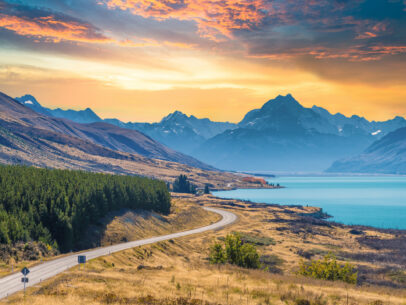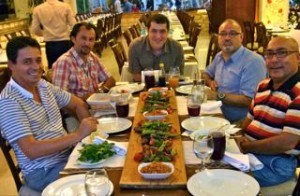
The Bird’s Word Blog
Turkish Delights

In August 2011, Journeys President Robin Weber Pollak and her husband Joe Pollak traveled to Turkey to scout it out for future Journeys trips. Joe wrote this post about his experience in Istanbul.
Day 1: Istanbul
Robin and I arrived a bit jet-lagged, but ready to go. We were met at the airport by Omer, our city guide. Omer has about 25 years of guiding experience and is pretty much the perfect city guide because he seems to know all the security guards and ticket takers and directed us to several excellent experiences which are open to tourists but not in the guidebooks. In short, he is exactly the type of guide that Journeys likes to work with: friendly, knowledgeable, and attentive. Since this was a scouting trip, our goal was to see as much of Turkey as possible, as quickly as possible. Omer’s ability to expedite our entrance to sites was especially useful.
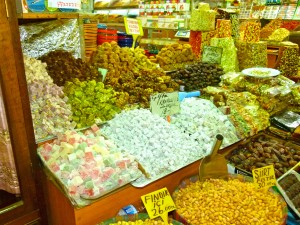 We stayed in a boutique hotel in the Old City of Istanbul. Istanbul is unique because it sits on two continents – the Old City in Europe and the New City in Asia. The country’s tourism ministry has designated the entire Old City to be a historical zone and limits re-development of existing structures. The boutique hotels are renovated, historic townhouses, and to accommodate travelers’ expectations, the hotel developers have crammed tiny 4-person elevators into the existing structures. There are larger, more modern hotels in the New City, but, if you can handle small elevators, the boutique hotels are closer to the sites and the action.
We stayed in a boutique hotel in the Old City of Istanbul. Istanbul is unique because it sits on two continents – the Old City in Europe and the New City in Asia. The country’s tourism ministry has designated the entire Old City to be a historical zone and limits re-development of existing structures. The boutique hotels are renovated, historic townhouses, and to accommodate travelers’ expectations, the hotel developers have crammed tiny 4-person elevators into the existing structures. There are larger, more modern hotels in the New City, but, if you can handle small elevators, the boutique hotels are closer to the sites and the action.
Underground Cistern
Our first sightseeing stop was the Basilica Cistern. Istanbul is riddled with underground cisterns, which were used as part of an aqueduct system to transport water 30 miles from the mountains to the city. It is cool and dark, with rows and rows of parallel stone columns and archways. This particular cistern features columns recycled from other ancient sites. Two columns from an older temple were a bit too short so the columns were shimmed with blocks with a carved Medusa image. Unlike in the movies, the image of Medusa was considered a sign of protection or luck. Omer told us that the cistern foreman must have scavenged the stones from an earlier structure without regard to meaning, because the stones are upside down and sideways.
Blue Mosque
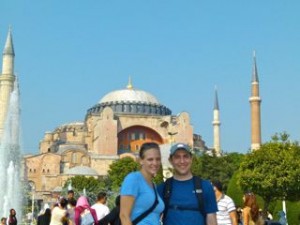 Next, we visited the Blue Mosque — probably the most famous site in Turkey. The proper name is the Sultan Ahmed Mosque because the Ottoman Sultan Ahmed I built it in the early 1600s. In Muslim tradition, human images are not used for decoration, so the interior is covered with blue ceramic tiles in interesting geometric patterns. The mosque is still used for prayer and is a popular place to go during the month of Ramadan (which began two days after we arrived). The mosque is briefly closed to tourists during prayer times, but after a quick negotiation with the guard, Omer slipped us inside just before the doors closed and we noted the benefit of traveling with an experienced guide!
Next, we visited the Blue Mosque — probably the most famous site in Turkey. The proper name is the Sultan Ahmed Mosque because the Ottoman Sultan Ahmed I built it in the early 1600s. In Muslim tradition, human images are not used for decoration, so the interior is covered with blue ceramic tiles in interesting geometric patterns. The mosque is still used for prayer and is a popular place to go during the month of Ramadan (which began two days after we arrived). The mosque is briefly closed to tourists during prayer times, but after a quick negotiation with the guard, Omer slipped us inside just before the doors closed and we noted the benefit of traveling with an experienced guide!
Grand Bazaar
After the Blue Mosque, we stopped at the Grand Bazaar, a massive building crammed with 4,000 booths and stores. We thought that the shopkeepers seemed aggressive, but I’m not really sure what their call of, “Yes, please?” was supposed to evoke. Maybe they imagined that I said, “Would you like to sell me a ‘genuine fake watch’?” “Yes, please!”
There are some super-luxury goods in the Grand Bazaar: diamonds, high-end leather jackets, designer purses; but also a collection of pomegranate tea, brightly colored scarves, hand-painted ceramic tiles, Turkish delight stuffed with pistachios and flavored with rose water, and other souvenirs.
Turkish Bath
In the late afternoon we started to feel the jet lag, so Omer suggested a visit to the Turkish bath, or Hamam. The public sauna that we know as a “Turkish” bath could also be called a “Roman” bath. The Romans built baths with stone walls and a raised marble floor. Under the raised floor they built large hearths to provide heat to create steam.
Hot running water for bathing is a rather recent luxury in Turkey, even in cosmopolitan Istanbul. Later in our trip, we met guides born in the 1980s who told us that as children growing up in Istanbul their mothers would heat water on the kitchen stove for washing.
Our pre-trip research revealed both positive and negative descriptions of the modern Turkish bath experience. We heard that some Turkish baths are overpriced operations that prey on tourists and that women should insist on a female attendant. Omer directed us to the Turkish bath that he frequents, and we valued the recommendation.
Inside the bath we disrobed in individual, private changing rooms. Men received a towel-like wrap and women a somewhat larger wrap. In this establishment the men’s section was actually the co-ed section. We sat on marble benches absorbing the steam while we waited for our individual scrub down services. There was a marble platform in the center of the bath where the attendants provide the service for male visitors. Women were periodically taken to a separate, women-only room.
When it was my turn, I lay on the platform and the attendant went to work with his exfoliating mitt. He then covered me in soap suds for a scrub down and very brief massage. Men wear their wraps the whole time but let’s just say that the attendant was thorough. He also told me that I had been “very dirty” and tried to show me all the dead skin on his exfoliating mitt.
Apparently, the package that Omer negotiated for us included a shampoo. I saw the bottle, and the shampoo was definitely something off the shelf from the Turkish version of Walgreens, not anything that would be used in a spa in the United States… or at least in a U.S. spa they would put the shampoo in a fancy bottle.
The whole service, including a generous tip, was about $30 each. Well worth it, I thought.
Day 2: Istanbul
Topkaki Palace
Today, we went to Topkapi Palace and the Turkey Archaeological museum.
Topkapi Palace was the Ottoman Sultan’s residence until the 1850s. The palace treasury is full of gem-encrusted gifts given to the Sultan by other empires, including a dagger given by Queen Victoria with three humongous emeralds. Also in the treasury is a reliquary. I’m usually not interested in relics, but I had never before heard that the staff of Moses is in a museum in Turkey and was fascinated to see what they presented as such. Also featured: the turban of Saint Joseph. Unfortunately, I realized later that Turkish people refer to both Joseph (Hebrew Bible) and Joseph (Christian Bible) as Saint Joseph — so I’m not sure which Joseph wore the turban. The Turkish Tourism Ministry also asserts that Noah landed on Turkish soil on Mount Ararat, making sure that visitors read that the parts of the mountain controlled by Iran, Armenia, and Azerbaijan cannot make this claim.
Finally, Topkapi Palace is also a shrine to the Prophet Mohammed and includes his swords, bow, beard clippings, and robe. Everyone calls the Prophet’s Robe the “Holy Cardigan” which is an unfortunate translation for Americans, because the word “cardigan” makes me think of Perry Como and Mr. Rogers – not the Prophet Mohammed. I think that it is accurate that the Holy Cardigan is made of wool and has buttons on the front, but it is too sacred to be openly displayed, so I do not know for sure.
On the way out of the Palace we made a very brief stop at the Turkey Archaeological Museum to see the highlights of its collection. After learning that I was an attorney, Omer made sure to show us the Code of Hammurabi (according to law school the first written law — although there are competing claims as to which version is the earliest, Turkey has a tablet with a pretty old version of the code) and the Treaty of Kadesh (according to law school the first treaty — between the Hittites and Egyptians). We also saw Alexander the Great’s sarcophagus.
 In the evening Omer and the rest of the staff of our local operation in Turkey took us out for dinner, or really, a feast. We went to an excellent restaurant where they actually ordered food by the meter, unless something was lost in translation. Ours came on a 1.5 meter long board, and our hosts insisted that we try every kind of kebab available. When a boy in a superhero costume walked by, we thought maybe it was a meat-induced hallucination, but it turned out this restaurant was a favorite spot for celebrating the coming -of-age ceremony for Istanbul’s preteens, and Superman was that night’s guest of honor. Our glimpse into Turkey’s local customs was just beginning. Tomorrow we would fly to central Turkey to experience the more traditional way of life in the region of Cappadocia.
In the evening Omer and the rest of the staff of our local operation in Turkey took us out for dinner, or really, a feast. We went to an excellent restaurant where they actually ordered food by the meter, unless something was lost in translation. Ours came on a 1.5 meter long board, and our hosts insisted that we try every kind of kebab available. When a boy in a superhero costume walked by, we thought maybe it was a meat-induced hallucination, but it turned out this restaurant was a favorite spot for celebrating the coming -of-age ceremony for Istanbul’s preteens, and Superman was that night’s guest of honor. Our glimpse into Turkey’s local customs was just beginning. Tomorrow we would fly to central Turkey to experience the more traditional way of life in the region of Cappadocia.
Journeys International offers group and custom departures to Turkey. Many of Journeys’ departures include a Mediterranean cruise on a traditional, wooden sailing vessel called a “gulet.” Joe says that on his next trip to Turkey he wants to sail on a gulet, spend more time at the Turkey Archaeological Museum, and eat more Turkish delight.
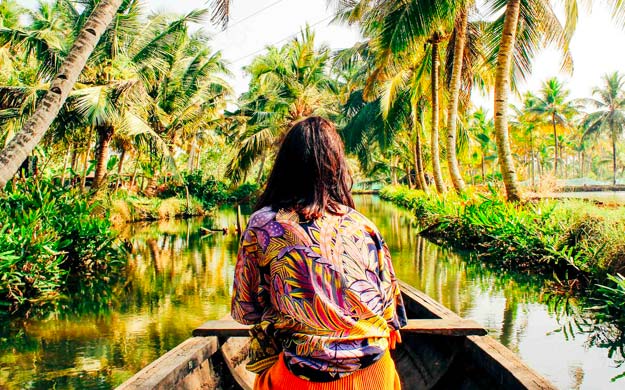
Design an adventure with Journeys International!
With over 40 years of experience, we create experiences that match your goals.
Start Planning